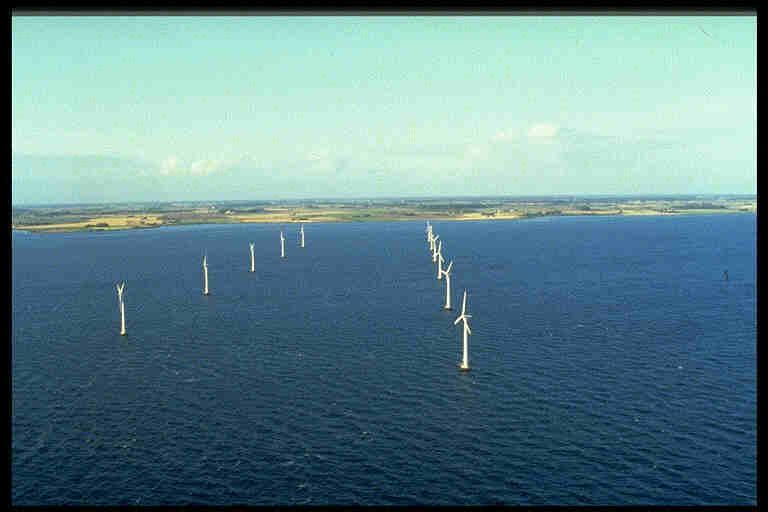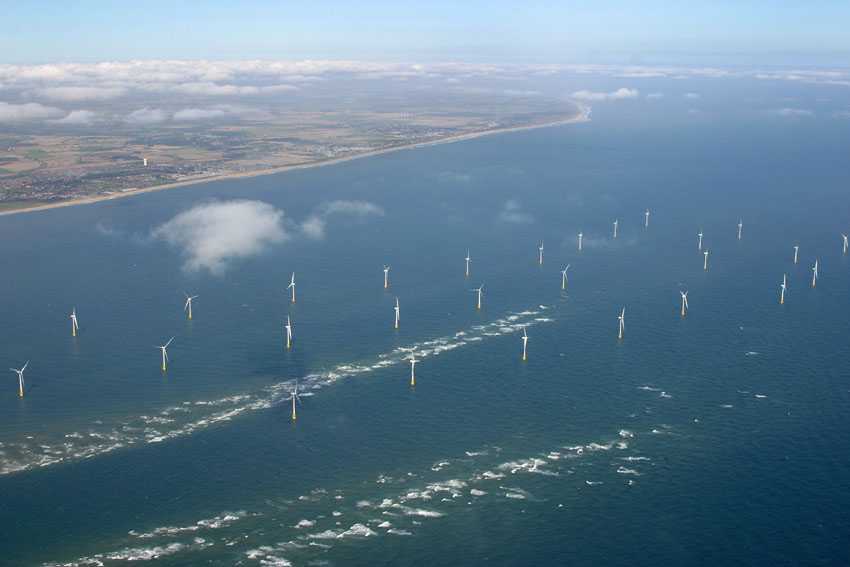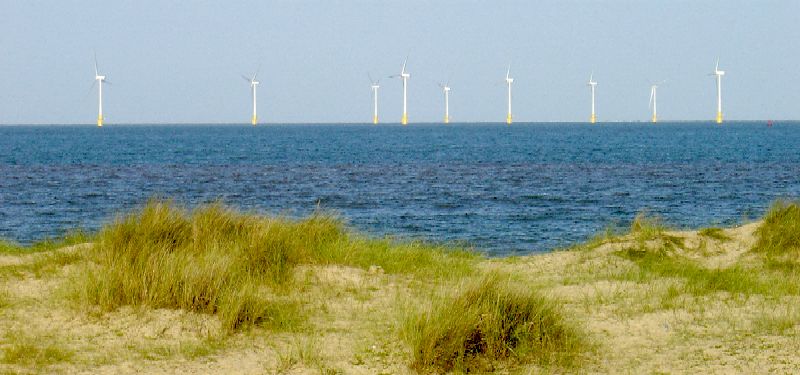| Windfarms, ornithologists, and bird societies |
(3686) |
| MONEY CREATES CONFLICTS OF INTEREST THAT ARE A THREAT TO BIRD LIFE |
| Among others, a controversy affects a project to implant 130 wind turbines on a shoal in the Nantucket Sound opposite Cape Cod. The area is biologically important for sea creatures, and protected bird species are also at risk. The wind turbines will be erected along a major migration flyway, and may kill an estimated 6,600 birds a year. - Yet the local bird society MA Audubon supports the project. |
.
.

Above picture : offshore windfarm off the European coast.
Marine mammals and life on the sea bed may be affected, as wind turbines emit vibrations. Whales and dolphins are known to sometimes strand themselves on beaches, where they die. Some have emitted the hypothesis that the cause of this behaviour could be linked to noise from ships´ engines and propellers. Is it wise in the circumstances to increase underwater acoustic pollution ?
Bird life too will be impacted. The Massachussets Audubon Society ( "MA Audubon" ) has been opposing the project from the beginning. They estimated that the turbines may kill up to 6,600 birds per year (1).
The controversy arose when MA Audubon changed their minds. They announced they would support the project on the condition that millions of dollars be spent to mitigate the ecological impact. As mitigation includes the monitoring of bird mortality and bird behaviour by ornithologists, this immediately led to suspicions of a conflict of interest.
Barbara Durkin, of Massachussets, tried to evaluate roughly how much money was involved, and voiced her concern :
quote
The Adaptive Management Plan monitoring contract valuation provided by Michael Boyd, incorporated with the contract duration terms provided by MA Audubon, reveals the estimated contract value that is a condition of MA Audubon´s support of Cape Wind.
Estimated Cape Wind AD monitoring contract value:
Year one= $3 million startup
(Two construction years any one´s guess)= $2 million @ $1 million per year
Continuing at least 3 years post construction= $3 million @ 1 million per year
The approximate value over term is close to $8 million per MA Audubon´s specified terms in their Challenge conditional support for Cape Wind, this expressed contract.
If MA Audubon admits that Adaptive Management Plan is a contract, they will have to explain why they have not disclosed potential financial interest in their campaign for this project as a permit reviewing agency wielding wide influence to gain support for Cape Wind.
The very fact that Taber Allison and Jack Clarke of MA Audubon both continue to deny that Adaptive Management monitoring and mitigation is handled by contract-- is a red flag. This action seriously calls into question their objectivity as a participating agency in the world´s largest environmental review process. Bias, on the part of any Cape Wind reviewing agency, particularly as relates to Cape Wind´s most vocal project proponent, MA Audubon, is something we need to guard vigilantly against.
Barbara Durkin
unquote
The exact amount of the fund to be set up for the monitoring is not publicly known. So Mrs Durkin based her estimate on the amount said to be paid for monitoring bird mortality at Altamont Pass, as disclosed by Michael Boyd. It is a very rough estimate of course, as the two windfarms are quite different. But it has the merit of showing that we are talking about millions of dollars.

Above picture : offshore windfarm at Scroby Sands, Eastern England.
And here is an article by Dona Tracy, of Cape Cod, on the same subject : 7 million dollar contract to count dead birds and propose "solutions"
Millions of dollars to count dead birds, observe flight patterns, recommend doubtful mitigation ... Windfarms are a bonanza for a great many ornithologists, and for prominent bird societies. In the UK, a controversy affects the Royal Society for the Protection of Birds ( "RSPB" ) : they lend ( for money ) their name to a product called "RSPB Energy" - see : RSPB executives are causing severe harm to bird life.
In Spain, SEO/Birdlife strongly supports the development of windfarms ; but they admitted to receiving donations from windpower interests ( Iberdrola and Banco Triodos ).
Ethics are the big loser in this saga, after our bird life ; and the reputation of ornithologists in general comes out tarnished.

Above picture : offshore windfarm off the European coast.
In 2001, MA Audubon wrote the following :
"...birds are most likely to strike the towers at the times when it is most difficult or impossible to directly monitor with human observers; i.e. at night and/or during inclement weather."
Yet now they are happy with the project, provided it is monitored during 5 years ! - The conflict of interest is palpable.
And...
"...We are particularly concerned that single, unusual events such as a mass bird collision with the structures during inclement weather could result in significant mortality that would be difficult to predict, avoid, or document.
Question : if it is "difficult to predict, avoid, or document", how on earth can they pretend to be able to mitigate it ?
And this :
"...This particular project site is an area with one of the highest concentrations of seaducks and terns on the Atlantic seaboard. The shoals at this location provide ample feeding opportunities for birds. The site is also located along a major migratory bird flightway. We do not agree with the ENF’s unsupported conclusions that avian risks are small or that bird use in the area is low."
They were acting responsibly, then.
"... Because large numbers of birds utilize the area regularly, we are concerned that the risk may be unacceptable."
Yet now they consider the risk to be acceptable, provided the developer employs ornithologists to, ahem, monitor the turbines and propose mitigation if need be.
Mitigation doesn´t work. It hasn´t at Altamont Pass, where many wind turbines were relocated, and the rest were shut off during 2 months of intense bird activity. That was drastic mitigation, and yet it failed (2). Altamont consultant Jerry McNerney suggested that mortality will abate when bigger turbines replace the old ones. But a scientific study targeting the same windfarm already showed that bigger turbines kill more birds (3).
When ornithologists support structures that kill millions of birds worldwide (4), who will look after the survival of avian species ?
- There is something terribly wrong here.
When the dust settles, bird societies will be held accountable for the biological disaster to be caused by windfarms.
Mark Duchamp...................................................................April 11th 2008
The negative effects of windfarms: links to papers published by Mark Duchamp
Pictures of birds killed by windfarms, etc.
More pictures
FOOTNOTES
(1) - Letter of February 23, 2005 from Laura Johnson, President of MA Audubon, to the US Army Corps of Engineers ( authors of the Environmental Impact Statement for the Cape Wind project ), presenting the bird society´s comments on the said EIS - available upon request to : save.the.eagles@gmail.com
(2) - "Even then, the scientists opined that a four-month shutdown might only reduce deaths by roughly 30 percent." Altamont
(3) - Chilling Statistics FOOTNOTE nº 25
(4) - Chilling Statistics
| Insertado
por: Mark Duchamp (26/01/2008) |
| Fuente/Autor:
Mark Duchamp |
Valoración
Comentarios
|
